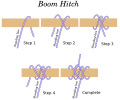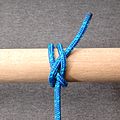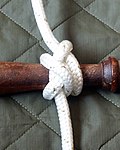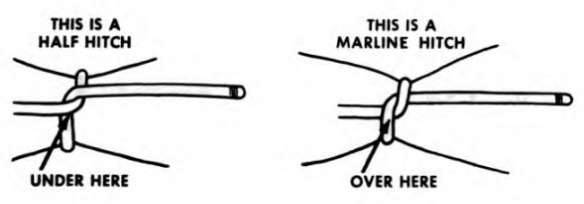| Knot | Description | Image |
|---|
| Adjustable grip hitch | A simple and useful friction hitch which may easily be shifted up and down the rope while slack. |  |
| Alternate ring hitching | A type of ringbolt hitching formed with a series of alternate left and right hitches made around a ring |  |
| Anchor bend | A knot used for attaching a rope to a ring |  |
| Bale sling hitch | A knot which traditionally uses a continuous loop of strap to form a cow hitch around an object in order to hoist or lower it. |  |
| Barrel hitch | The "barrel hitch" and "barrel sling," named for their use in hoisting cargo aboard ships, are a simple yet effective way to suspend an object. |  |
| Becket hitch | Any hitch that is made on an eye loop, i.e., on a becket. |  |
| Blackwall hitch | A temporary means of attaching a rope to a hook. |  |
| Blake's hitch | A friction hitch commonly used by arborists and tree climbers as an ascending knot. |  |
| Boom hitch | A rather robust and secure method of attaching a line, or rope to a fixed object like a pipe, post, or sail boom |  |
| Bottom-loaded release hitch | | |
| Buntline hitch | A knot used for attaching a rope to an object. It is formed by passing the working end around an object, then making a clove hitch around the rope's standing part, taking care that the turns of the clove hitch progress towards the object rather than away from it. | |
| Cat's paw | A knot used for connecting a rope to an object. |  |
| Chain hitch | A knot used to connect a rope to a cylindrical object. Similar to the marline hitch, but formed with successive Clove hitch knots. |  |
| Clinging clara | | |
| Clove hitch | A clove hitch is two successive half-hitches around an object. |  |
| Continuous ring hitching | A series of identical hitches made around a ring |  |
| Cow hitch variant | | |
| Cow hitch with toggle | | |
| Cow hitch | A hitch knot used to attach a rope to an object. |  |
| Double overhand noose | A hitch knot used to bind a rope to a carabiner. |  |
| Farrimond friction hitch | A quick release adjustable friction hitch for use on lines under tension. |  |
| Garda hitch | A ratcheting knot used to disallow dual direction rope travel. |  |
| Gripping sailor's hitch | A secure, jam-proof hitch used to tie one rope to another, or a rope to a pole, boom, spar, etc., when the pull is lengthwise along the object. |  |
| Ground-line hitch | A type of knot used to attach a rope to an object. |  |
| Half hitch | A simple overhand knot, where the working end of a line is brought over and under the standing part. |  |
| Halter hitch | A type of knot used to connect a rope to an object. |  |
| Highpoint hitch | A type of knot used to attach a rope to an object. |  |
| Highwayman's hitch | A quick-release draw loop knot used for temporarily securing a rope that will need to be released easily and cleanly. |  |
| Hitching tie | A simple knot used to tie off stuff sacks that allows quick access as it unties quickly. |  |
| Icicle hitch | A knot for connecting to a post when weight is applied to an end running parallel to the post in a specific direction. |  |
| Improved clinch knot | Also known as the Salmon Knot, a knot that is often used for securing a fishing line to a hook or lure. |  |
| Killick hitch | A type of hitch knot used to attach a rope to oddly shaped objects. |  |
| Knute hitch | A knot used to attach a lanyard of small stuff to a marlingspike or other tool. | |
| Magnus hitch | A knot used to attach a rope to a rod, pole, or other rope. (See also Rolling hitch) |  |
| Marline Hitching | A knot used to attach a rope to a cylindrical object. Similar in appearance to the Chain Hitch, but a succession of overhand knots. |  |
| Marlinespike hitch | A temporary knot used to attach a rod to a rope in order to form a handle. |  |
| Midshipman's hitch | An adjustable loop knot for use on lines under tension. |  |
| Munter hitch | A simple knot, commonly used by climbers and cavers as part of a life-lining or belay system |  |
| Ossel hitch | A knot used to attach a rope or line to an object. |  |
| Palomar knot | A knot that is used for securing a fishing line to a fishing lure, snap or swivel. |  |
| Pile hitch | A kind of hitch, which is a knot used for attaching rope to a pole or other structure. |  |
| Pipe hitch | A hitch-type knot used to secure smooth cylindrical objects. |  |
| Prusik knot | A friction hitch or knot used to put a loop of cord around a rope, applied in climbing, canyoneering, mountaineering, caving, rope rescue, and by arborists. |  |
| Reverse half hitches | | |
| Round turn and two half-hitches | |  |
| Sailor's hitch | A secure, jam-proof hitch. |  |
| Siberian hitch | A knot used to attach a rope to an object. |  |
| Slippery hitch | A knot used to attach a line to a rod or bar. |  |
| Snell knot | A hitch knot used to attach an eyed fishing hook to fishing line. | |
| Snuggle hitch | A modification of the clove hitch |  |
| Taut-line hitch | An adjustable loop knot for use on lines under tension. |  |
| Tensionless hitch | An anchor knot used for rappelling or rope rescue. | |
| Timber hitch | A knot used to attach a single length of rope to a cylindrical object. |  |
| Trilene knot | A multi-purpose fishing knot that can be used for attaching monofilament line to hooks, swivels and lures. | |
| Trucker's hitch | A compound knot commonly used for securing loads on trucks or trailers. |  |
| Tugboat hitch (Lighterman's hitch) | An easy release knot ideal for heavy towing. | |
| Tumble hitch | A quick-release draw loop knot used for temporarily securing a rope that will need to be released easily and cleanly. |  |
| Two half-hitches | A type of knot, specifically a binding knot or hitch knot. |  |
| Uni knot | A multi purpose fishing knot that can be used for attaching the fishing line to the arbor of a reel, for joining lines, and for attaching lures, snaps, and swivels. |  |
















































